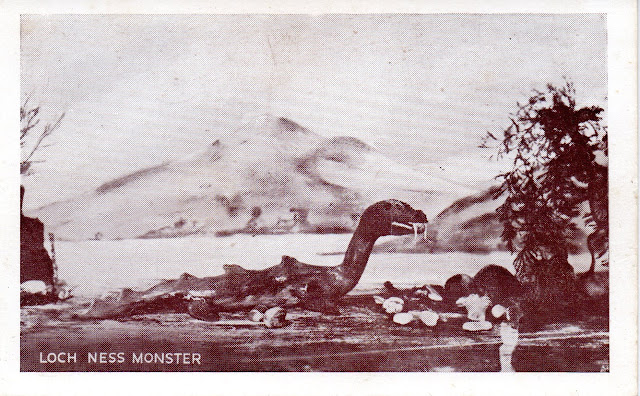Series: N/A
Catalogue: N/A
Artist: Unknown
Type: Lithography
Usage: Unused
While many vintage Nessie postcards are accomplished works of art, there are some exceptions. Take this card for example, which was issued, I believe, around 1934. So the title of this entry is a bit of a misnomer, but do bear with me...
My dating is tentative, for I have not yet seen a postally-used example. But the postcard might have been printed much earlier, or even much later than the date I suggest.
A much later date is suggested by the notably flimsy stock, almost a thick paper, on which the card is printed. This is more typical of the war-shortage years of the 1940s than the salad days of the 1930s.
But to counter a later dating, we have to reckon with a glaring anachronism; namely the undivided cardback, which is marked prominently with the words "Address only to be written on this side." As postcard collectors are aware, this "undivided back," and the legal admonition that often accompanied it, is a hallmark of cards produced in the UK before January 1902. After this date, with only a few exceptions, postcards issued in the UK could have messages as well as an address included on the reverse.
If this card was produced before 1902, it would constitute stunning new evidence of the vaunted historical tradition of a creature in Loch Ness predating the sensations of 1933.
So, the physical evidence suggests that we are either dealing with a Nessie postcard issued in or before 1901, or, alternatively, a card produced around 1940. Ever the contrarian, I have plumped instead for 1934. Why?
My reasoning is thus: this was the height of the postcard cash-ins on the popularity of the Loch Ness Monster. There was money to be made as visitors flocked to Loch Ness and surrounds and were eager to send back souvenirs and news of their visits. In addition to big companies like Valentine's and J.B. White, a host of small-time producers were also busy making and selling cards.
The motif on the card is typical reflection of 1930s speculation concerning Nessie as a saurian. It is possibly significant that the caption reads "Loch Ness Monster", a designation that only gradually came to acceptance over late 1933 and early 1934. I have already discussed another small-press card from 1934 that was rather more reticent in calling Nessie a "monster."
Let's add to that the fact that no other Monster postcard seems to have been produced before around September or October of 1933.
The image itself seems to be a photo of a plasticine model, together with rocks, twigs, and leaves, which has been photographed against a painted background depicting the waters of the Loch and the Scottish highlands. If I have a few beers and squint really hard, I believe I can discern Castle Urquhart at the very centre of the background. The design is untypical of Nessie cards for combining both 3D and 2D elements.
The postcard appears to have been printed in a somewhat crude halftone lithographic process, as opposed to the more popular 'real photo' type, in which each card is produced and developed from a negative in a fashion similar to a standard photograph.
The unusual method of printing is perhaps indicative of the card being a product of a fly-by-night operation who didn't normally produce photographic postcards. This type of producer may well have been unaware that the days of the divided back had arrived. Or perhaps it might have been a bootleg or knock-off of a card produced by another manufacturer?
While I therefore don't think that this card is proof of the existence of a monster tradition in the Loch pre-dating 1933, it is nevertheless quite a curio. In the meantime I will keep my eyes peeled for a used example, which may shed more light on the situation.
UPDATE (9 March 2021)
I have come across photos of the same postcard on the auction site Delcampe, this time printed with a more familiar divided back.
Alas, from what I can determine, this image offers little more to go on than previous research had revealed. Which wasn't much! It remains to be determined which of the two known versions was issued first, and indeed if one version (I suspect the undivided back) is a pirated printing of the other.




Interesting, but i think the title "loch ness monster" probably dates it to the 1930s.
ReplyDelete